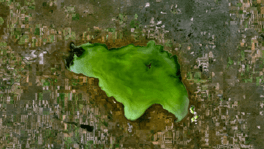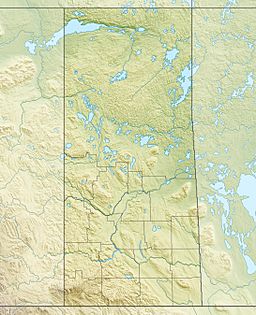Old Wives Lake facts for kids
Quick facts for kids Old Wives Lake |
|
|---|---|

Old Wives Lake, as seen from space.
|
|
| Location | Saskatchewan |
| Coordinates | 50°06′00″N 106°00′02″W / 50.10000°N 106.00056°W |
| Type | Saline |
| Primary inflows | Wood River |
| Basin countries | Canada |
Old Wives Lake is a large, shallow salty lake in south-central Saskatchewan, Canada. It's located about 30 kilometers southwest of Moose Jaw. The Wood River flows into the lake. Because the land around it is very flat, the lake often has large mudflats, especially when water levels change.
This lake is super important for birds! On March 9, 1925, it became a Migratory Bird Sanctuary. This means it's a safe place for birds to rest and live. Old Wives Lake, along with Reed Lake and Chaplin Lake, is part of a special area for shorebirds in North America. It was named a "site of hemispheric importance" in 1997. It's known as one of the most important inland spots for birds that travel long distances across North America.
The lake's interesting name comes from different First Nations stories. Over time, many groups have been interested in the lake. These include First Nations tribes, duck hunters, military trainers, and people who collected a mineral called sodium sulfate. Today, it's a popular spot for people who love to watch birds.
A small town called Old Wives is located north of the lake. You can find it on Highway 363.
Contents
Why is it called Old Wives Lake?
The name "Old Wives Lake" comes from several old stories passed down by First Nations people.
The Cree Story
One popular story comes from the Cree people. Around 1840, some Cree hunters were following bison into Blackfoot land. They set up camp near the lake. Blackfoot scouts found them and attacked. The Cree fought back, but they knew a bigger Blackfoot group would attack the next morning.
So, the older women in the Cree group decided to stay behind. They kept the campfires burning all night. This made the Blackfoot think the Cree were still there. While the Blackfoot were fooled, the rest of the Cree escaped safely back to their home in the Qu'Appelle valley. When the Blackfoot arrived the next morning, they found only the old women. Sadly, the Blackfoot killed them in revenge.
This brave act is remembered by a historical marker near Highway 2 by the lake. Another version of this story says the Blackfoot warriors were so impressed by the women's courage that they let them go.
The Assiniboine Stories
Another story comes from the Assiniboine people. It says that a group of Assiniboine were running from Blackfoot warriors. The older women couldn't keep up, so they were left behind. The women tried to escape by walking across the lake. But they didn't know how deep the water was and drowned.
An Assiniboine story also links the name to a battle around the early 1800s. In this battle, the Assiniboine defeated their Blackfoot enemies at the lake. Some First Nations traditions say that the spirits of the dead women can still be heard at night from a small island in the lake.
How the Name Changed Over Time
Some old records say that the name "Old Wives Lake" used to refer to both this lake and nearby Chaplin Lake. In 1861, two British politicians, Sir Frederick Johnstone and Henry Chaplin, visited the area. They came to hunt bison, antelope, and elk.
An explorer named John Rae was with them. He named the lakes after the visitors. The lake we now call Old Wives Lake was named Johnstone Lake. Chaplin Lake kept its name. The Canadian government officially called it "Johnstone Lake" in 1886. But the First Nations people, along with local ranchers and settlers, kept calling it Old Wives Lake.
In 1953, people living in the area asked for the traditional name to be brought back. So, the Canadian board that names places officially changed it back to Old Wives Lake.
History of Old Wives Lake
People have lived around Old Wives Lake for a very long time. We know this because Tipi rings (circles of stones that held down tipis) and other old tools have been found there. These show that First Nations people were in the area long before Europeans arrived.
Early Settlers and Hunters
When European settlers came, ranchers and homesteaders (people who settled on land) moved into the area around the lake. For a while, duck hunters would come to the lake in the fall. They hunted the many wild ducks and geese that gathered there. However, hunting was later stopped in the Old Wives Lake bird sanctuary to protect the birds.
World War II Training
During World War II, there was a special air training school near the lake. This school was part of the British Commonwealth Air Training Plan. It was located about three miles east of Mossbank. Pilots in training used part of the lake and its surroundings as a bombing range. This range was about 23 miles long!
Sodium Sulfate Harvesting
For several decades in the 1900s, especially in the 1950s and 1960s, a mineral called sodium sulfate was collected from the lake. Water from Old Wives Lake was moved into nearby Frederick Lake. The water would then evaporate, leaving the sodium sulfate behind. This plant operated until 1977.
Modern Times and Birdwatching
In 1975, two Canadian Forces military training planes crashed over the lake after hitting each other. Luckily, the two pilots in one plane were able to parachute out. They used emergency rubber boats to stay afloat until a helicopter rescued them.
Today, Old Wives Lake is a popular place for people who enjoy watching birds. There's a 2.4-kilometer walking trail along the lake's south shore. You can also find special viewing areas and picnic spots there.
Lake Conditions and Wildlife
Sometimes, the lake has completely dried up due to drought conditions. This happened in 1937 and 1988. In other years, like 1951, 1959, 1980, and 1997, many ducks were found dead at the lake. This was due to outbreaks of a sickness called botulism.


